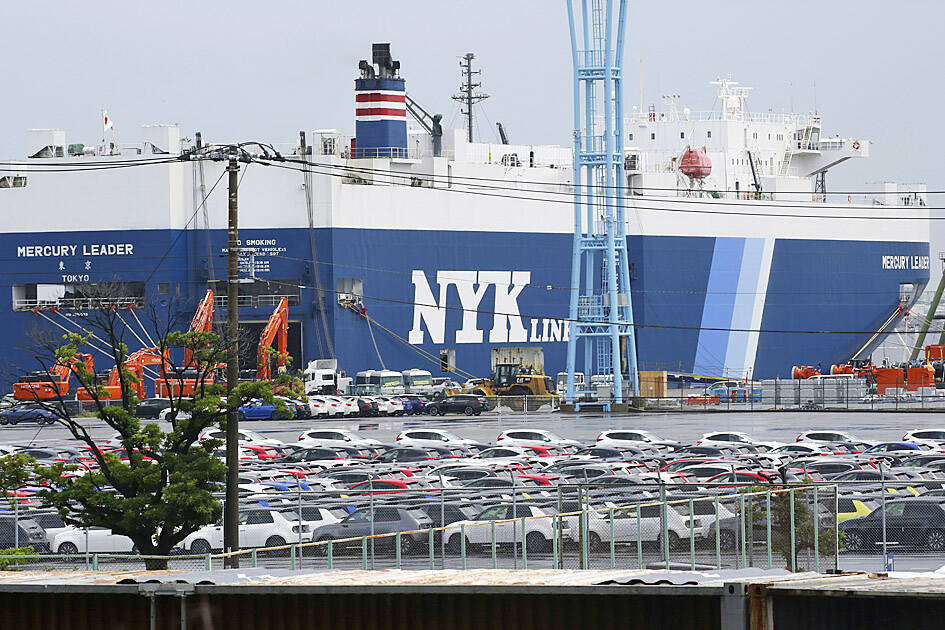Japanese exports grew more than expected last month, providing much-needed support for the economy, as shipments of vehicles and chip-related gear advanced.
Exports last month rose 11.9 percent from a year earlier, beating economists’ forecast of a 9.5 percent gain, the Japanese Ministry of Finance reported yesterday.
Imports slid for a 10th month, falling 9.6 percent, spurred by slides in coal and liquefied natural gas. That compared with consensus forecasts of an 8.7 percent decline.

Photo: AP
The timing of the Lunar New Year holidays skewed year-on-year comparisons by boosting exports to China. The trade balance flipped to a deficit of ¥1.76 trillion (US$11.74 billion) from a revised surplus of ¥68.9 billion.
The gain in exports, coming a month after a revised 9.7 percent rise in December last year, is a positive sign for Japan after the economy unexpectedly fell into recession in the final quarter of last year due to stagnant domestic spending.
The evidence that external demand is holding up is likely to underpin market views that the Bank of Japan can continue to move toward normalizing monetary policy, as many economists expect to happen by April. The central bank’s policy board has recently sought to assure markets that the first rate hike since 2007 would not result in radical changes, as policy settings would remain accommodative.
Bank of Japan Governor Kazuo Ueda last week reiterated his view that the bank would keep parsing data carefully to judge whether a gradual economic recovery would continue.
Yesterday’s figures were solid across the board. Exports to the US rose 15.6 percent, driven by vehicles and medical devices in the 28th straight month of increases.
Outbound shipments to the EU gained 13.8 percent, and exports to China rose 29.2 percent, as the number of working days this year increased compared with a year earlier due to the timing of the lunar new year.
Shipments of vehicles and auto parts, along with equipment for chipmaking, were the main engines of growth last month.

Taiwanese suppliers to Taiwan Semiconductor Manufacturing Co. (TSMC, 台積電) are expected to follow the contract chipmaker’s step to invest in the US, but their relocation may be seven to eight years away, Minister of Economic Affairs J.W. Kuo (郭智輝) said yesterday. When asked by opposition Chinese Nationalist Party (KMT) Legislator Niu Hsu-ting (牛煦庭) in the legislature about growing concerns that TSMC’s huge investments in the US will prompt its suppliers to follow suit, Kuo said based on the chipmaker’s current limited production volume, it is unlikely to lead its supply chain to go there for now. “Unless TSMC completes its planned six

Power supply and electronic components maker Delta Electronics Inc (台達電) yesterday said second-quarter revenue is expected to surpass the first quarter, which rose 30 percent year-on-year to NT$118.92 billion (US$3.71 billion). Revenue this quarter is likely to grow, as US clients have front-loaded orders ahead of US President Donald Trump’s planned tariffs on Taiwanese goods, Delta chairman Ping Cheng (鄭平) said at an earnings conference in Taipei, referring to the 90-day pause in tariff implementation Trump announced on April 9. While situations in the third and fourth quarters remain unclear, “We will not halt our long-term deployments and do not plan to

‘SHORT TERM’: The local currency would likely remain strong in the near term, driven by anticipated US trade pressure, capital inflows and expectations of a US Fed rate cut The US dollar is expected to fall below NT$30 in the near term, as traders anticipate increased pressure from Washington for Taiwan to allow the New Taiwan dollar to appreciate, Cathay United Bank (國泰世華銀行) chief economist Lin Chi-chao (林啟超) said. Following a sharp drop in the greenback against the NT dollar on Friday, Lin told the Central News Agency that the local currency is likely to remain strong in the short term, driven in part by market psychology surrounding anticipated US policy pressure. On Friday, the US dollar fell NT$0.953, or 3.07 percent, closing at NT$31.064 — its lowest level since Jan.

The New Taiwan dollar and Taiwanese stocks surged on signs that trade tensions between the world’s top two economies might start easing and as US tech earnings boosted the outlook of the nation’s semiconductor exports. The NT dollar strengthened as much as 3.8 percent versus the US dollar to 30.815, the biggest intraday gain since January 2011, closing at NT$31.064. The benchmark TAIEX jumped 2.73 percent to outperform the region’s equity gauges. Outlook for global trade improved after China said it is assessing possible trade talks with the US, providing a boost for the nation’s currency and shares. As the NT dollar